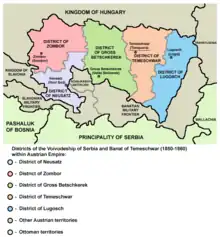| Lugos District | |||||||||
|---|---|---|---|---|---|---|---|---|---|
| district of the Voivodeship of Serbia and Banat of Temeschwar | |||||||||
| 1851–1860 | |||||||||
 Districts of the Voivodeship of Serbia and Banat of Temeschwar; Lugos District is shown in blue | |||||||||
| Capital | Lugos (Romanian: Lugoj) | ||||||||
| History | |||||||||
• Established | 1851 | ||||||||
• Disestablished | 1860 | ||||||||
| |||||||||
| Today part of | |||||||||
Lugos District (contemporary German: District von Lugos;[1] Kreis Lugos or Lugoser Kreis from 1854[2]) was one of five administrative districts (originally Districte, modern spelling Distrikte; Kreise, lit. 'circles', from 1854) of the Voivodeship of Serbia and Banat of Temeschwar (a crown land within the Austrian Empire) from 1851 to 1860. Its administrative centre was Lugos (Romanian: Lugoj, German: Lugosch).
History
The Voivodeship of Serbia and Banat of Temeschwar crown land was formed in 1849.[3] In 1851, it was divided into five districts: Lugos, Temesvár, Groß-Becskerek, Zombor and Neusatz.[1] Lugos District was based on the former territory of the Hungarian Krassó County.[1]
In German the original term used for these subdivisions was Districte[1] (modern spelling Distrikte). In 1851 they were divided into subdivisions called (politische) Bezirke,[1] usually translated as '(political) districts'.
In Bach's reforms from 1853[4] (formally applied to the crown land in 1854[2]) the Districte became Kreise, a form of administrative division already in use across much of the non-Hungarian part of the Empire since the 18th century. The term Kreis, literally 'circle', is also often translated as 'district'. The subdivisions of the Kreise were also called Bezirke in German, or Amtsbezirke ('office districts', in reference to the Bezirksämter or 'district offices' which ran them) to distinguish them from other types of Bezirk. The change of name was not superficial – different political, administrative and judicial structures were used in each subdivision type. (See also Districts of Austria § Habsburg Monarchy and Austrian Empire.)
In 1860, the crown land and its five districts were abolished; the territory of the Lugos District reverted to Krassó County under Hungary.
Geography
The Lugos District comprised the easternmost parts of Banat (the Military Frontier notwithstanding). It shared borders with the Temesvár District to the west, the Banat Military Frontier in the south and east, the Grand Principality of Transylvania (initially the Karlsburger Kreis, Kreis Broos from 1854) in the north-east, and the Hungarian Arad County in the north (all parts of the Austrian Empire). Until 1849 it had been the Hungarian Krassó County.
Today it lies almost entirely within Romania, with some small parts (the settlements of Banatska Subotica and Dobričevo and some small areas of unsettled land) within Serbia (Vojvodina).
Demographics
Subdivisions
In 1851 Lugos District was subdivided into 4 political districts (politische Bezirke),[1] which were structurally akin to the modern districts of Austria (names as defined,[1] modern German and other languages in parentheses):
- Lugos (German: Lugosch; Romanian: Lugoj; Serbo-Croatian: Lugoš)
- Facset (German: Fatschet; Romanian: Făget; Hungarian: Facsád)
- Oravitza (German: Orawitz; Romanian: Oravița; Hungarian: Oravicabánya; Serbo-Croatian: Oravica)
- Boksan (German: (Deutsch-)Bokschan; Romanian: Bocșa (Montană); Hungarian: Boksánbánya)
The city of Lugos was separate from the political districts; the Lugos district covered the area around the city, which acted as its seat/capital[1] (i.e. it was a statutory city).
In 1854 Lugos District (now a Kreis) was subdivided into 4 'office districts' (Amtsbezirke) (names as defined):[2]
References
- 1 2 3 4 5 6 7 8 Gesetz vom 17. August 1851, 192/1851: "Verordnung des Ministeriums des Innern, womit die durch Allerhöchste Entschließung sanctionirte Organisation der politischen Verwaltung der Woiwodschaft Serbien und des Temeser Banates kundgemacht wird". Reichs-Gesetz-Blatt für das Kaiserthum Österreich (in German). 1851-08-17. Retrieved 2023-07-19 – via ÖNB-ALEX - Historische Rechts- und Gesetztexte Online.
- 1 2 3 Gesetz vom 1. Februar 1854, RGBl. 28/1854: "Verordnung der Minister des Inneren, der Justiz und der Finanzen vom 1. Februar 1854, betreffend die politische und gerichtliche Organisirung der serbischen Woiwodschaft und des Temeser Banates". Reichs-Gesetz-Blatt für das Kaiserthum Österreich (in German). 1854-02-01. Retrieved 2023-07-19 – via ÖNB-ALEX - Historische Rechts- und Gesetztexte Online.
- ↑ Patent vom 18. November 1849, RGBl. 25/1849: "Kaiserliches Patent vom 18. November 1849, womit das, die Bacska und das Banat, den Rumáer und Illokér Bezirk umfassende Territorium vorläufig zu einem eigenen Verwaltungsgebiete unter der Benennung: „Woiwodschaft von Serbien und Temeser Banat" gebildet, dessen Untertheilung in Kreise und Bezirke angeordnet, und dem kaiserlichen Titel Sr. Majestät der eines „Großwoiwoden der Woiwodschaft Serbien" beigefügt wird". Reichs-Gesetz-Blatt für das Kaiserthum Österreich (in German). 1849-11-18. Retrieved 2023-07-19 – via ÖNB-ALEX - Historische Rechts- und Gesetztexte Online.
- ↑ Gesetz vom 19. Jänner 1853, RGBl. 10/1853: "Verordnung der Minister des Inneren, der Justiz und der Finanzen vom 19. Jänner 1853, womit die Allerhöchsten Entschließungen über die Einrichtung und Amtswirksamkeit der Bezirksämter, Kreisbehörden und Statthaltereien, über die Einrichtung der Gerichtsstellen und das Schema der systemisirten Gehalte und Diätenclassen, sowie über die Ausführung der Organisirung für die Kronländer Oesterreich ob und unter der Enns, Böhmen, Mähren, Schlesien, Galizien und Lodomerien mit Krakau, Bukowina, Salzburg, Tirol mit Vorarlberg, Steiermark, Kärnthen, Krain, Görz, Gradiska und Istrien mit Triest, Dalmatien, Kroatien und Slawonien, Siebenbürgen, die serbische Wojwodschaft mit dem Banate, kundgemacht werden". ÖNB-ALEX - Historische Rechts- und Gesetztexte Online (in German). 1853-01-19. Retrieved 2023-07-19.